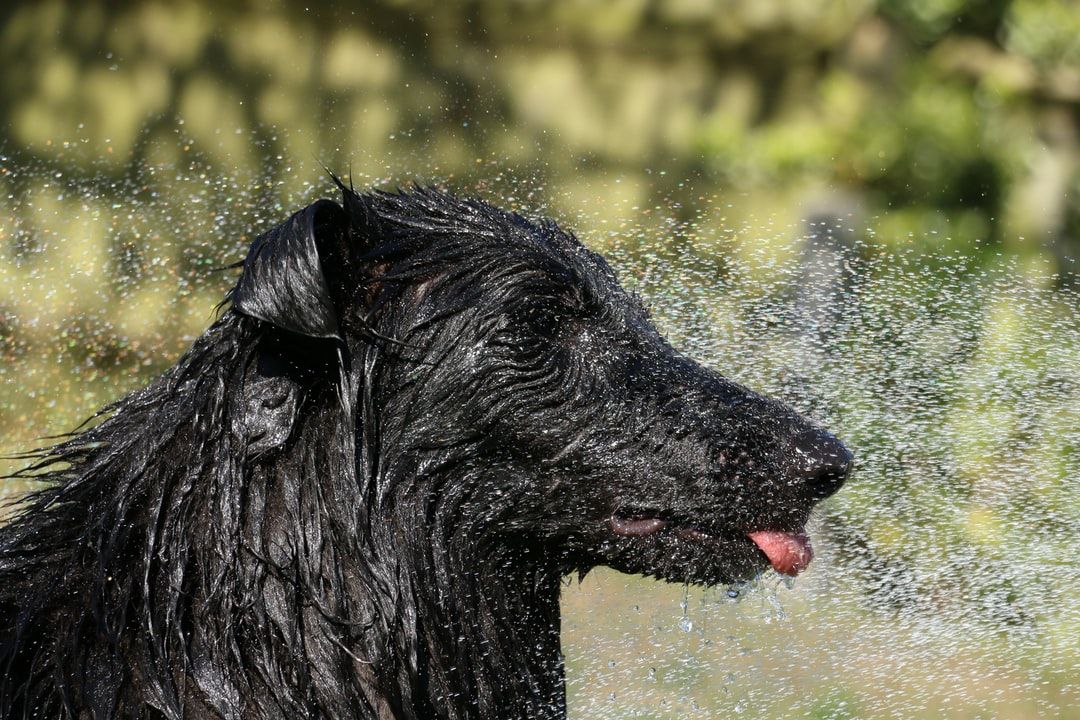Dog training has come a long way in recent years and yet some methods that are rather archaic still exist in the dog world. Despite science demonstrating how dogs learn and the benefits of positive reinforcement, such techniques still manage to resurface. Why is this the case? Well, in most cases the use of aversive tools and methods is a result of a lack of knowledge regarding, what an aversive is, how they work and the potential behavioural fall out. With this is in mind, this blog is going to consider 3 important reasons to avoid aversive training.
An Aversive Must Be Unpleasant To Have An Effect
Aversive tools range from shaking rocks in a bottle and spraying water to using slip leads and prong collars (or neck chains like the one above). Although many may believe one is worse than another, each one is classed as an aversive.
Many justify the use of aversive training by claiming most aren’t harmful or unpleasant for dogs but sadly this isn’t true. In order for an aversive to stop an unwanted behaviour, it has to be unpleasant for the dog. If its not uncomfortable or unpleasant, it won’t stop the unwanted behaviour because the dog doesn’t consider it aversive. Another thing we have to remember, is our dogs will decide what they find aversive. We may try and rank aversive training from mild to severe but in reality, only our dog knows what they find unpleasant or uncomfortable.
Therefore, the aversive that we perceive as innocent in nature, may be very traumatic to our dog. Thus, we cannot justify the use of such methods by convincing ourselves that the aversive isn’t that unpleasant.
Many justify the use of aversive training by claiming most aren’t harmful or unpleasant for dogs but sadly this isn’t true. In order for an aversive to stop an unwanted behaviour, it has to be unpleasant for the dog. If its not uncomfortable or unpleasant, it won’t stop the unwanted behaviour because the dog doesn’t consider it aversive. Another thing we have to remember, is our dogs will decide what they find aversive. We may try and rank aversive training from mild to severe but in reality, only our dog knows what they find unpleasant or uncomfortable.
Therefore, the aversive that we perceive as innocent in nature, may be very traumatic to our dog. Thus, we cannot justify the use of such methods by convincing ourselves that the aversive isn’t that unpleasant.

Aversive Methods Don’t Address The Cause Of Behaviour
Many decide to use an aversive approach because they seem quick to stop unwanted behaviour. Use of spray bottles are perceived to stop excessive barking, using slip leads supposedly stop leash pulling and shock collars supposedly stop reactivity amongst other behaviours. Are all these examples of aversives really effective in stopping unwanted behaviour?
Well, let’s consider an illustration. Imagine a child is feeling upset about school, due to bullying he isn’t willing to talk about. His emotions may result in tantrums and efforts to avoid going to school. Rather than ask questions to determine why their child is behaving this way, the parents smack him every time he gets upset. Does this stop the unwanted behaviour? Well, the child may stop crying and may even stop moaning about school but does that indicate the issue is resolved? No because the child still feels those emotions about school but now he know longer trusts his parents to be comfortable enough to express how he’s feeling.
Well, let’s consider an illustration. Imagine a child is feeling upset about school, due to bullying he isn’t willing to talk about. His emotions may result in tantrums and efforts to avoid going to school. Rather than ask questions to determine why their child is behaving this way, the parents smack him every time he gets upset. Does this stop the unwanted behaviour? Well, the child may stop crying and may even stop moaning about school but does that indicate the issue is resolved? No because the child still feels those emotions about school but now he know longer trusts his parents to be comfortable enough to express how he’s feeling.
Therefore, the outward behaviour has been stopped but those emotions have been suppressed. Over time, other behavioural issues will rear their head because the source of the problem hasn’t been addressed. This is the exact same problem with using an aversive tool or method in dog training. They don’t stop unwanted behaviours, they trigger the dog to hide them. This means other behaviour issues will develop because the true reason behind the behaviour isn’t being addressed.

The Aversive Has To Get Stronger Because The Dog Habituates
One of the most shocking truths regarding aversive tools and methods is, they eventually have to be escalated.
For instance, spraying water in the dog’s face may stop a dog from barking at first, however, if this aversive is used often, the dog can become habituated to it. This means that any aversive may seem to stop the behaviour initially but after regular use, the dog becomes accustomed to it and goes back to displaying their old behaviour. Therefore, the guardians then have to find a new aversive and escalate the unpleasantness to stop the unwanted behaviour once more. In extreme cases, this has led to prong collars actually cutting flesh in the dog’s neck and even severe burns on the throat from a shock collar. When one aversive suddenly stop working, guardians can become desperate and this is a slippery slope. Where do we draw the line between behaviour management to animal abuse?
For instance, spraying water in the dog’s face may stop a dog from barking at first, however, if this aversive is used often, the dog can become habituated to it. This means that any aversive may seem to stop the behaviour initially but after regular use, the dog becomes accustomed to it and goes back to displaying their old behaviour. Therefore, the guardians then have to find a new aversive and escalate the unpleasantness to stop the unwanted behaviour once more. In extreme cases, this has led to prong collars actually cutting flesh in the dog’s neck and even severe burns on the throat from a shock collar. When one aversive suddenly stop working, guardians can become desperate and this is a slippery slope. Where do we draw the line between behaviour management to animal abuse?
In reality, aversive tools and approaches are a temporary fix for a problem that will never be adequately addressed unless ethical training is implemented. Not only will the aversive escalate, so will the number of behaviour issues as a result. Using aversive methods can cause so much emotional damage that behaviour becomes very unpredictable as a result, and your relationship with your dog will be part of that fallout. Thus, we cannot justify the use of such horrible training methods by persuading ourselves they aren’t impacting our dogs emotionally. We can’t convince ourselves that the unpleasantness will be worth it because the behaviour will be forever gone, when we know it’s only suppressed. Neither can we deceive ourselves into thinking that we will never escalate the aversive when it inevitably stops working.

Thanks to so many scientific studies, we have a wealth of research on how to effectively address dog behaviour. The use of positive reinforcement has no end of benefits and its results are far superior to those observed in aversive training. It is simple to find rewards we know our dog will love and using them correctly will mean we reinforce the behaviours we do want to see and change any negative associations into positive ones. We can also escalate our rewards to even better ones to keep our dog optimistic and motivated to learn.
So, why even consider using aversives when we can achieve better training, that truly strengthens our bond with our dog with positive reinforcement?
So, why even consider using aversives when we can achieve better training, that truly strengthens our bond with our dog with positive reinforcement?
Start Your FREE Skill-Hub Trial Today
Commitment Free 3 Day Access
Canine Principles' Skill-Hub allows unlimited* access to ALL self-study courses, workshops & webinars.
*Requires Monthly Subscription. See Skill-Hub Subscription Page For Details.

